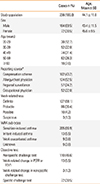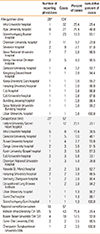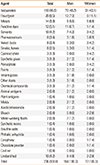1. Masoli M, Fabian D, Holt S, Beasley R. Global Initiative for Asthma (GINA) Program. The global burden of asthma: executive summary of the GINA Dissemination Committee report. Allergy. 2004; 59:469–478.
2. Subbarao P, Mandhane PJ, Sears MR. Asthma: epidemiology, etiology and risk factors. CMAJ. 2009; 181:E181–E190.
3. Jang AS, Kim SH, Kim TB, Park HW, Kim SH, Chang YS, et al. Impact of atopy on asthma and allergic rhinitis in the cohort for reality and evolution of adult asthma in Korea. Allergy Asthma Immunol Res. 2013; 5:143–149.
4. Antó JM, Sunyer J, Basagaña X, Garcia-Esteban R, Cerveri I, de Marco R, et al. Risk factors of new-onset asthma in adults: a population-based international cohort study. Allergy. 2010; 65:1021–1030.
5. Kogevinas M, Zock JP, Jarvis D, Kromhout H, Lillienberg L, Plana E, et al. Exposure to substances in the workplace and new-onset asthma: an international prospective population-based study (ECRHS-II). Lancet. 2007; 370:336–341.
6. Vandenplas O. Occupational asthma: etiologies and risk factors. Allergy Asthma Immunol Res. 2011; 3:157–167.
7. McDonald JC, Chen Y, Zekveld C, Cherry NM. Incidence by occupation and industry of acute work related respiratory diseases in the UK, 1992-2001. Occup Environ Med. 2005; 62:836–842.
8. Provencher S, Labrèche FP, De Guire L. Physician based surveillance system for occupational respiratory diseases: the experience of PROPULSE, Quebec, Canada. Occup Environ Med. 1997; 54:272–276.
9. Kang SK, Kim EA. Occupational diseases in Korea. J Korean Med Sci. 2010; 25:S4–S12.
10. Kang SY, Chu JK. Studies on the sea-squirt allergy in Korea. J Korean Med Assoc. 1976; 19:935–942.
11. Oh SS, Kim KS. Occupational asthma in Korea. J Korean Med Sci. 2010; 25:S20–S25.
12. Chae CH, Choi SW, Choi YH, Jin YW, Kim EA, Kang SK. The work-related cases among bronchial asthma diagnosed at a university hospital in Incheon. Korean J Occup Environ Med. 1999; 11:174–180.
13. Kim HR, Hong YC, Leem JH, Won JU, Chun HJ, Lee JN, et al. Characteristics of occupational asthma reported by surveillance system in Incheon. Korean J Occup Environ Med. 2003; 15:344–350.
14. Kang SK, Jee YK, Nahm DH, Min KU, Park JW, Park HS, et al. A status of occupational asthma in Korea through the cases reported to the Occupational Asthma Surveillance Center. J Asthma Allergy Clin Immunol. 2000; 20:906–915.
15. Kim JH, Park SG, Leem JH, Won JU, Han SH, Chung SY, et al. Area-based occupational disease surveillance in Incheon, Korea: results of an 11-year data survey. Korean J Occup Environ Med. 2010; 22:183–199.
16. Tarlo SM, Lemiere C. Occupational asthma. N Engl J Med. 2014; 370:640–649.
17. Klees JE, Alexander M, Rempel D, Beckett W, Rubin R, Barnhart S, et al. Evaluation of a proposed NIOSH surveillance. Case definition for occupational asthma. Chest. 1990; 98:212S–215S.
18. Jajosky RA, Harrison R, Reinisch F, Flattery J, Chan J, Tumpowsky C, et al. Surveillance of work-related asthma in selected U.S. states using surveillance guidelines for state health departments--California, Massachusetts, Michigan, and New Jersey, 1993-1995. MMWR CDC Surveill Summ. 1999; 48:1–20.
19. Ministry of Employment and Labor (KR). Report on the establishment status 2006. Seoul: Ministry of Employment and Labor;2006.
20. Ministry of Employment and Labor (KR). Survey report on labor conditions by employment type 2006. Seoul: Ministry of Employment and Labor;2008.
21. Statistics Korea. Korean standard industrial classification 2000. Daejeon: Statistics Korea;2000.
22. Statistics Korea. Korean standard classification of occupations 2000. Daejeon: Statistics Korea;2000.
23. Hook EB, Regal RR. Capture-recapture methods in epidemiology: methods and limitations. Epidemiol Rev. 1995; 17:243–264.
24. Ameille J, Pauli G, Calastreng-Crinquand A, Vervloët D, Iwatsubo Y, Popin E, et al. Reported incidence of occupational asthma in France, 1996-99: the ONAP programme. Occup Environ Med. 2003; 60:136–141.
25. Bakerly ND, Moore VC, Vellore AD, Jaakkola MS, Robertson AS, Burge PS. Fifteen-year trends in occupational asthma: data from the Shield surveillance scheme. Occup Med (Lond). 2008; 58:169–174.
26. Henneberger PK, Kreiss K, Rosenman KD, Reilly MJ, Chang YF, Geidenberger CA. An evaluation of the incidence of work-related asthma in the United States. Int J Occup Environ Health. 1999; 5:1–8.
27. Esterhuizen TM, Hnizdo E, Rees D. Occurrence and causes of occupational asthma in South Africa--results from SORDSA's Occupational Asthma Registry, 1997-1999. S Afr Med J. 2001; 91:509–513.
28. Hannaford-Turner K, Elder D, Sim MR, Abramson MJ, Johnson AR, Yates DH. Surveillance of Australian workplace Based Respiratory Events (SABRE) in New South Wales. Occup Med (Lond). 2010; 60:376–382.
29. Karjalainen A, Kurppa K, Virtanen S, Keskinen H, Nordman H. Incidence of occupational asthma by occupation and industry in Finland. Am J Ind Med. 2000; 37:451–458.
30. Wong GW, Leung TF, Ko FW. Changing prevalence of allergic diseases in the Asia-pacific region. Allergy Asthma Immunol Res. 2013; 5:251–257.
31. McNamee R, Carder M, Chen Y, Agius R. Measurement of trends in incidence of work-related skin and respiratory diseases, UK 1996-2005. Occup Environ Med. 2008; 65:808–814.
32. Paris C, Ngatchou-Wandji J, Luc A, McNamee R, Bensefa-Colas L, Larabi L, et al. Work-related asthma in France: recent trends for the period 2001-2009. Occup Environ Med. 2012; 69:391–397.
33. Calvert GM, Lee K, Roh S, Davis KG, Tak S. Promoting and protecting worker health and safety in the Republic of Korea agricultural sector. J Agromedicine. 2012; 17:326–337.
34. Milton DK, Solomon GM, Rosiello RA, Herrick RF. Risk and incidence of asthma attributable to occupational exposure among HMO members. Am J Ind Med. 1998; 33:1–10.
35. Tilling K. Capture-recapture methods--useful or misleading? Int J Epidemiol. 2001; 30:12–14.
36. Torén K. Self reported rate of occupational asthma in Sweden 1990-2. Occup Environ Med. 1996; 53:757–761.
37. Siracusa A, Kennedy SM, DyBuncio A, Lin FJ, Marabini A, Chan-Yeung M. Prevalence and predictors of asthma in working groups in British Columbia. Am J Ind Med. 1995; 28:411–423.
38. Rosenman KD, Reilly MJ, Kalinowski DJ. A state-based surveillance system for work-related asthma. J Occup Environ Med. 1997; 39:415–425.
39. Orriols R, Costa R, Albanell M, Alberti C, Castejon J, Monso E, et al. Reported occupational respiratory diseases in Catalonia. Occup Environ Med. 2006; 63:255–260.
40. Walls C, Crane J, Gillies J, Wilsher M, Wong C. Occupational asthma cases notified to OSH from 1996 to 1999. N Z Med J. 2000; 113:491–492.
41. Hur GY, Koh DH, Kim HA, Park HJ, Ye YM, Kim KS, et al. Prevalence of work-related symptoms and serum-specific antibodies to wheat flour in exposed workers in the bakery industry. Respir Med. 2008; 102:548–555.
42. Quirce S, Diaz-Perales A. Diagnosis and management of grain-induced asthma. Allergy Asthma Immunol Res. 2013; 5:348–356.
43. Kim CW, Cho JH, Leem JH, Ryu JS, Lee HL, Hong YC. Occupational asthma due to azodicarbonamide. Yonsei Med J. 2004; 45:325–329.
44. Nahm DI, Ye YM, Kim JE, Suh CH, Nahm DH, Park HS. Occupational asthma and rhinitis due to cyanoacrylate glue. Korean J Asthma Allergy Clin Immunol. 2005; 25:231–233.
45. Burge PS, Moore VC, Robertson AS. Sensitization and irritant-induced occupational asthma with latency are clinically indistinguishable. Occup Med (Lond). 2012; 62:129–133.
46. Lee SN, Lee SJ, Noh JK, Lee MS, Lee NS, Lee BG, et al. A case of suspected occupational asthma caused by rabbit fur. Korean J Asthma Allergy Clin Immunol. 2008; 28:309–312.
47. Song JC, Kim YK, Yoon HJ, Park CS, Kim CW, Kim HR, et al. Surveillance of occupational asthma in Korea. Report No.: 2010-OSHRI-1101. Incheon: Korea Occupational Safety and Health Agency, Occupational Safety and Health Research Institute;2010.










 PDF
PDF ePub
ePub Citation
Citation Print
Print


 XML Download
XML Download